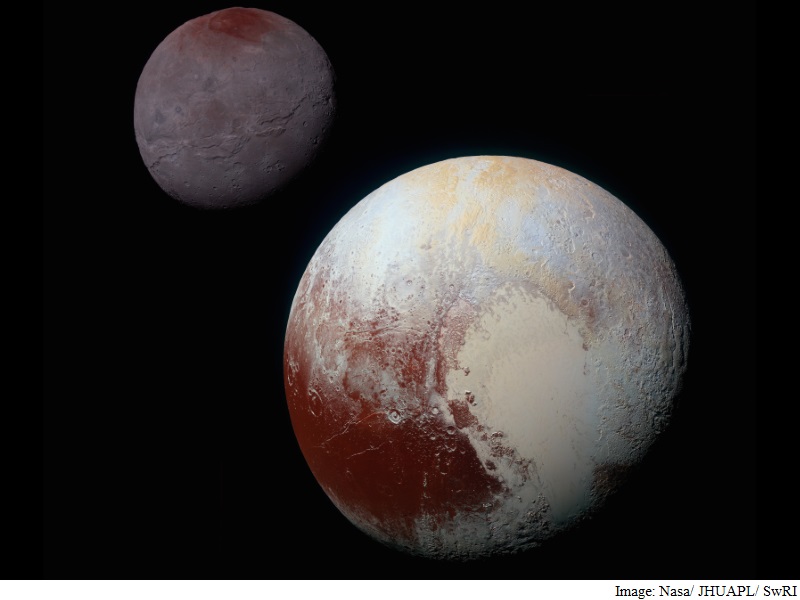- Home
- Science
- Science News
- Nasa Papers Reveal Details of Pluto's Moons
Nasa Papers Reveal Details of Pluto's Moons

"These five detailed papers completely transform our view of Pluto - revealing the former 'astronomer's planet' to be a real world with diverse and active geology, exotic surface chemistry, a complex atmosphere, puzzling interaction with the Sun and an intriguing system of small moons," said New Horizons principal investigator Alan Stern.
After a 9.5-year, three-billion-mile journey - launching faster and traveling farther than any spacecraft to reach its primary target - New Horizons zipped by Pluto on July 14, 2015.
New Horizons' seven science instruments collected about 50 gigabits of data on the spacecraft's digital recorders, most of it coming over nine busy days surrounding the encounter, Nasa said in a statement.
The first close-up pictures revealed a large heart-shaped feature carved into Pluto's surface, telling scientists that this "new" type of planetary world - the largest, brightest and first-explored in the mysterious, distant "third zone" of our solar system known as the Kuiper Belt - would be even more interesting and puzzling than models predicted.
"Observing Pluto and Charon up close has caused us to completely reassess thinking on what sort of geological activity can be sustained on isolated planetary bodies in this distant region of the solar system, worlds that formerly had been thought to be relics little changed since the Kuiper Belt's formation," said Jeff Moore, lead author of the geology paper.
Scientists studying Pluto's composition say the diversity of its landscape stems from eons of interaction between highly volatile and mobile methane, nitrogen and carbon monoxide ices with inert and sturdy water ice.
(Also see: Frigid Pluto Is Home to More Diverse Terrain Than Expected)
"We see variations in the distribution of Pluto's volatile ices that point to fascinating cycles of evaporation and condensation," said Will Grundy of the Lowell Observatory, Flagstaff, Arizona, lead author of the composition paper.
"These cycles are a lot richer than those on Earth, where there's really only one material that condenses and evaporates -- water. On Pluto, there are at least three materials, and while they interact in ways we don't yet fully understand, we definitely see their effects all across Pluto's surface."
Above the surface, scientists discovered Pluto's atmosphere contains layered hazes, and is both cooler and more compact than expected. This affects how Pluto's upper atmosphere is lost to space, and how it interacts with the stream of charged particles from the Sun known as the solar wind.
Scientists also are analysing the first close-up images of Pluto's small moons - Styx, Nix, Kerberos and Hydra.
They have found evidence that some of the moons resulted from mergers of even smaller bodies, and that their surface ages date back at least four billion years.
About half of New Horizons' flyby data has now been transmitted home -- from distances where radio signals at light speed need nearly five hours to reach Earth - with all of it expected back by the end of 2016.
Catch the latest from the Consumer Electronics Show on Gadgets 360, at our CES 2026 hub.
Related Stories
- Samsung Galaxy Unpacked 2025
- ChatGPT
- Redmi Note 14 Pro+
- iPhone 16
- Apple Vision Pro
- Oneplus 12
- OnePlus Nord CE 3 Lite 5G
- iPhone 13
- Xiaomi 14 Pro
- Oppo Find N3
- Tecno Spark Go (2023)
- Realme V30
- Best Phones Under 25000
- Samsung Galaxy S24 Series
- Cryptocurrency
- iQoo 12
- Samsung Galaxy S24 Ultra
- Giottus
- Samsung Galaxy Z Flip 5
- Apple 'Scary Fast'
- Housefull 5
- GoPro Hero 12 Black Review
- Invincible Season 2
- JioGlass
- HD Ready TV
- Laptop Under 50000
- Smartwatch Under 10000
- Latest Mobile Phones
- Compare Phones
- OPPO A6c
- Samsung Galaxy A07 5G
- Vivo Y500i
- OnePlus Turbo 6V
- OnePlus Turbo 6
- Itel Zeno 20 Max
- OPPO Reno 15 Pro Mini 5G
- Poco M8 Pro 5G
- Lenovo Yoga Slim 7x (2025)
- Lenovo Yoga Slim 7a
- Realme Pad 3
- OPPO Pad Air 5
- Garmin Quatix 8 Pro
- NoiseFit Pro 6R
- Haier H5E Series
- Acerpure Nitro Z Series 100-inch QLED TV
- Asus ROG Ally
- Nintendo Switch Lite
- Haier 1.6 Ton 5 Star Inverter Split AC (HSU19G-MZAID5BN-INV)
- Haier 1.6 Ton 5 Star Inverter Split AC (HSU19G-MZAIM5BN-INV)

















